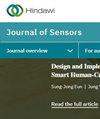Modeling Forest Above-Ground Biomass of Teak (Tectona grandis L. F.) Using Field Measurement and Sentinel-2 Imagery
IF 1.1
4区 工程技术
Q3 ENGINEERING, ELECTRICAL & ELECTRONIC
引用次数: 0
Abstract
Over the last few decades, remote sensing has emerged as a dependable and cost-effective method for collecting precise data on forest biophysical parameters, aiding in sustainable forest management and global initiatives to combat climate change. This research aimed to develop a model for estimating the above-ground biomass (AGB) of Teak (Tectona grandis L. F.) by combining field measurements with Sentinel-2 earth observation data. The study took place in 36-year-old teak plantation areas within the Sagarnath Forest Development Project in Nepal’s Sarlahi district. Field measurements were conducted using a destructive systematic sampling method, employing 10 × 10 m2 sample plots, and the volume of logs was determined using Newton’s formula. A total of 30 sample plots were used for calibration, while 10 were utilized for validation purposes. The findings revealed that the average AGB per plot was 814 kg (equivalent to 81.4 t ha−1), with a minimum value of 716 kg (71.6 t ha−1) and a maximum value of 1,060 kg (106 t ha−1). The study utilized five independent variables, namely, the Red band, Green band, Blue band, near-infrared (NIR), and normalized difference vegetation index (NDVI) values from Sentinel-2 imagery data, to develop estimation models. Among the 12 models examined, model M10 proved to be the best fit for accurate AGB estimation (adjusted R2 = 0.9809, RMSE = 0.01269, AIC = −170, and p-value = < 8.39e−21). The equation of the best-fitted model was ln (AGB) = A + B × Red + C × Green + D × Blue2 + E × ln (NIR) + F × ln (NDVI), providing an accurate estimate of AGB. Model validation involved a t-test comparing the observed and calculated AGB values for ten sample plots, demonstrating no significant difference (p-value = 0.3662 > 0.05). This model has the potential to facilitate AGB biomass calculations and carbon stock estimates for teak plantations of similar age groups.利用实地测量和哨兵-2 图像模拟柚木(Tectona grandis L. F.)的森林地上生物量
过去几十年来,遥感技术已成为收集森林生物物理参数精确数据的可靠且具有成本效益的方法,有助于可持续森林管理和应对气候变化的全球倡议。这项研究旨在通过将实地测量结果与哨兵-2 号地球观测数据相结合,建立一个估算柚木(Tectona grandis L. F.)地上生物量(AGB)的模型。研究在尼泊尔萨尔拉希县萨加纳特森林开发项目的 36 年柚木种植区进行。实地测量采用破坏性系统取样法,使用 10 × 10 平方米的样地,并使用牛顿公式确定原木的体积。共有 30 块样地用于校准,10 块样地用于验证。研究结果显示,每个样地的平均 AGB 为 814 千克(相当于 81.4 吨/公顷),最小值为 716 千克(71.6 吨/公顷),最大值为 1,060 千克(106 吨/公顷)。研究利用五个自变量,即哨兵-2 图像数据中的红波段、绿波段、蓝波段、近红外(NIR)和归一化差异植被指数(NDVI)值,建立了估算模型。在研究的 12 个模型中,模型 M10 被证明是最适合准确估算 AGB 的模型(调整 R2 = 0.9809,RMSE = 0.01269,AIC = -170 和 p 值 = <8.39e-21)。最佳拟合模型方程为 ln (AGB) = A + B × Red + C × Green + D × Blue2 + E × ln (NIR) + F × ln (NDVI),提供了对 AGB 的准确估计。模型验证包括对十块样地的观测值和计算值进行 t 检验,结果显示两者无显著差异(p 值 = 0.3662 >0.05)。该模型可用于类似树龄组柚木种植园的 AGB 生物量计算和碳储量估算。
本文章由计算机程序翻译,如有差异,请以英文原文为准。
求助全文
约1分钟内获得全文
求助全文
来源期刊

Journal of Sensors
ENGINEERING, ELECTRICAL & ELECTRONIC-INSTRUMENTS & INSTRUMENTATION
CiteScore
4.10
自引率
5.30%
发文量
833
审稿时长
18 weeks
期刊介绍:
Journal of Sensors publishes papers related to all aspects of sensors, from their theory and design, to the applications of complete sensing devices. All classes of sensor are covered, including acoustic, biological, chemical, electronic, electromagnetic (including optical), mechanical, proximity, and thermal. Submissions relating to wearable, implantable, and remote sensing devices are encouraged.
Envisaged applications include, but are not limited to:
-Medical, healthcare, and lifestyle monitoring
-Environmental and atmospheric monitoring
-Sensing for engineering, manufacturing and processing industries
-Transportation, navigation, and geolocation
-Vision, perception, and sensing for robots and UAVs
The journal welcomes articles that, as well as the sensor technology itself, consider the practical aspects of modern sensor implementation, such as networking, communications, signal processing, and data management.
As well as original research, the Journal of Sensors also publishes focused review articles that examine the state of the art, identify emerging trends, and suggest future directions for developing fields.
 求助内容:
求助内容: 应助结果提醒方式:
应助结果提醒方式:


